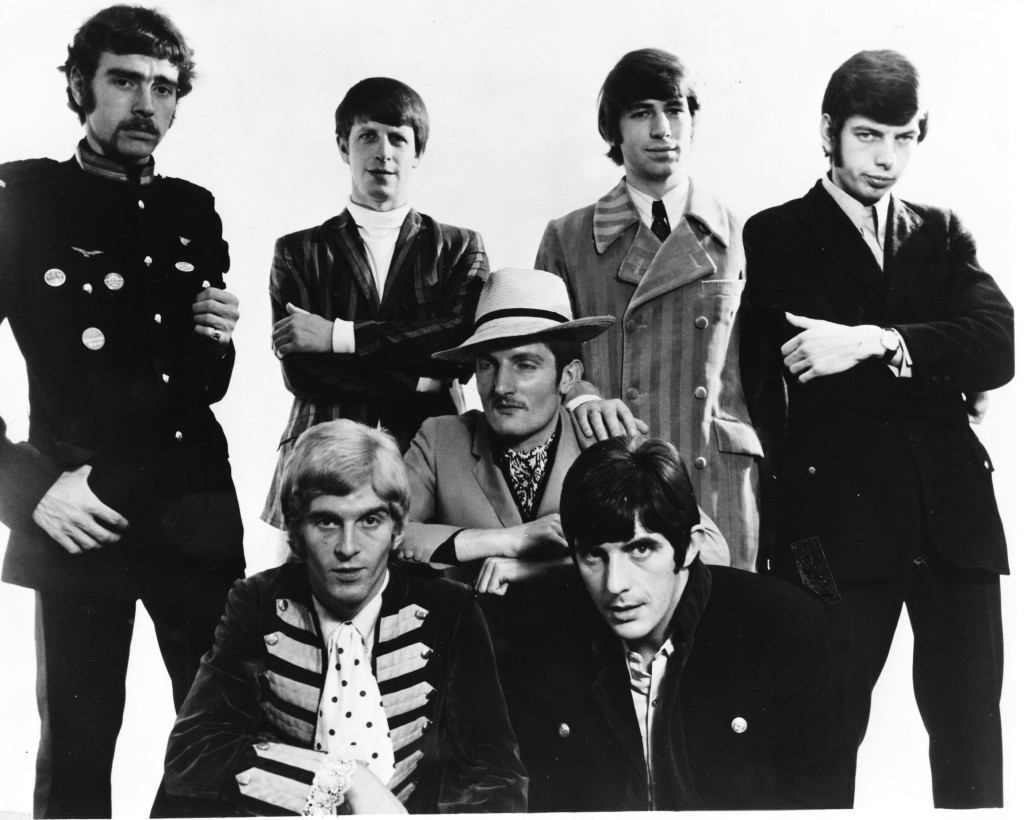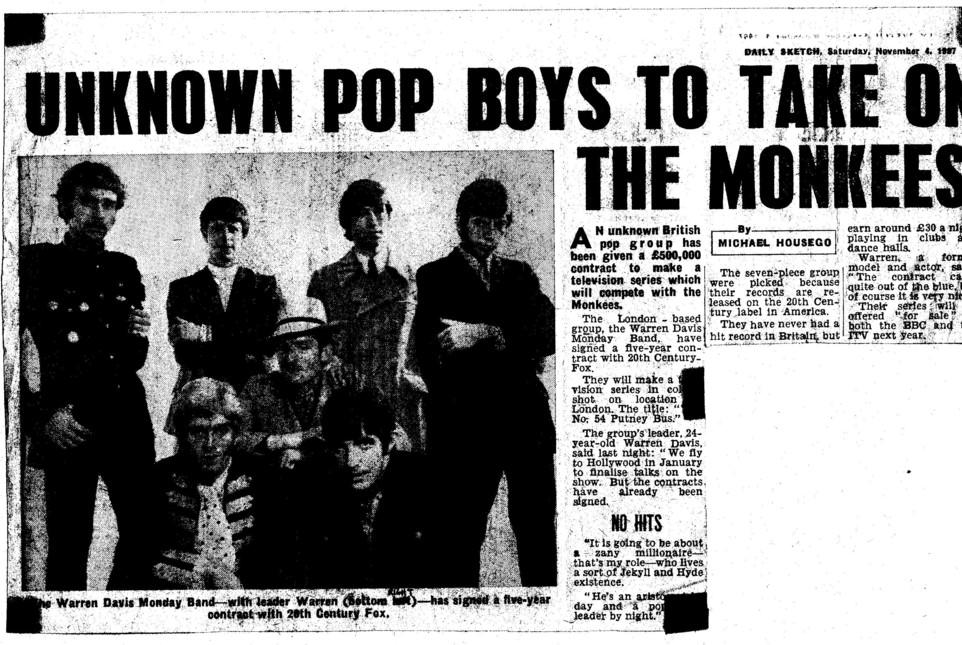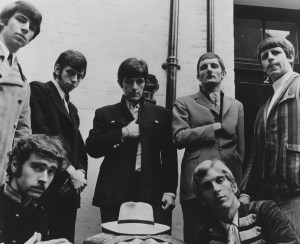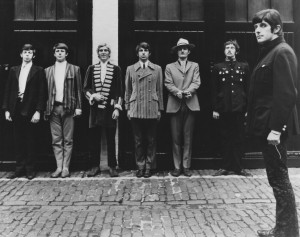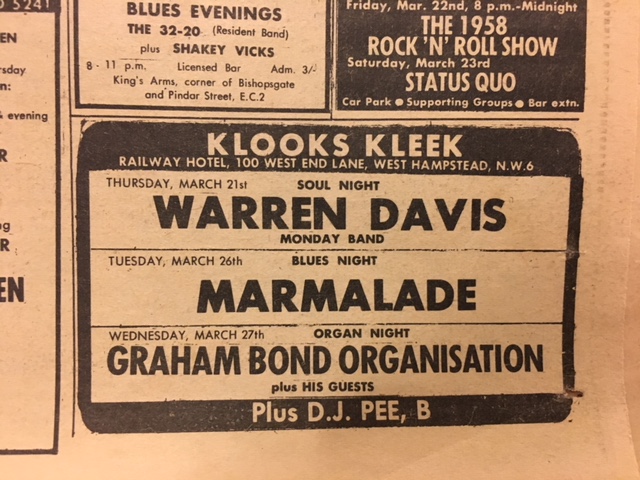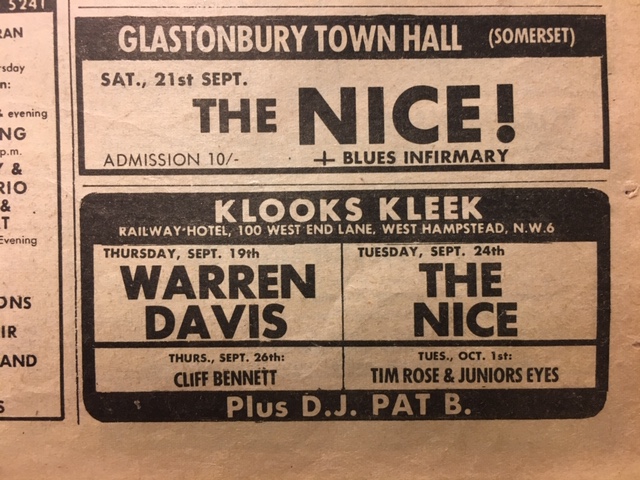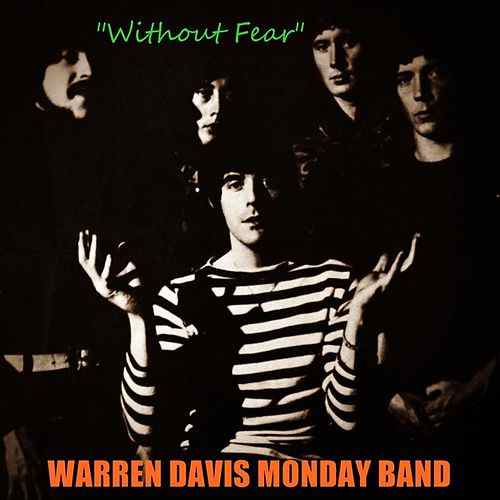By Nick Warburton
During The Warren Davis Monday Band’s short-lived career, the group were briefly associated with Rolling Stone Bill Wyman, who produced and co-wrote the A-side of their debut 45; were raved about by Hammond organist Booker T, who caught them one night in London during the spring ’67 Stax-Volt European tour; briefly included future Canadian rock legend, musician, record producer, composer, songwriter and arranger David Foster; and were the subject of a disastrous tabloid story, which reported they had signed a £500,000 contract with 20th Century Fox to make a TV series in California to compete with The Monkees.
Warren Davis Monday Band, late 1967: Clockwise from top left: Keith Beck, Del Paramor, Peter Mole, Martin Grice, Warren Davis, Paul Brett (wearing hat) and Paul Petts. Photo: Paul Brett
The one consistent thread throughout The Warren Davis Monday Band’s fascinating, yet tangled, career was former actor/model, turned singer Max Spinks (aka Warren Davis). It is his distinctive voice that links the dozen or so recordings that feature on a forthcoming CD anthology from US collectors’ label Lion Productions, which brings together pretty much everything the group cut between late 1966 and early 1968.
By early September 1967, Warren Davis, together with current members, sax players Martin Grice and Del Paramor and drummer Peter Mole, had rebuilt the group with guitarist/singer Paul Brett, bass player/singer Paul Petts and keyboard player Keith Beck.
On 4 November, The Warren Davis Monday Band’s career took an unexpected turn when the group was showcased in the then popular national newspaper, The Daily Sketch, which reported that the musicians had signed a £500,000 contract with 20th Century Fox for a TV series to be shot in Hollywood. The series, which was to be called Number 9 Putney Bus and which would compete with The Monkees, fell through in early 1968.
“We did stage auditions in London for 20th Century,” remembers Paul Petts. “We had to sing and play [and] do a lot of running around [and] posing. [It] was like The Monkees and was very exciting at the time. No other band was used in the UK. I don’t know the reason why it came to nothing. Maybe it was our lack of acting experience, although I believe Warren Davis had some experience.”
Martin Grice doesn’t recall much about the Daily Sketch episode but notes: “What happened there, I will never know. [All I do know is] it was supposed to be top secret, and someone let the cat out of the bag and that ruined the whole thing.”
Although the group would deny any involvement in music magazine Variety soon afterwards, the publicity generated from the story also coincided with a series of photo shoots in Fulham; the fruits of which can be seen on Alamy’s extensive photo collection.
Less than a week later, The Warren Davis Monday Band entered Tony Pike’s Music Studios in Putney, southwest London to record two original recordings over consecutive days.
Shelved at the time (and released on this CD for the first time), Paul Petts and Warren Davis’ superb “What’s It Like Down There?”, recorded on 8 November, and the Paul Brett-Paul Petts co-write, “Queen Victoria”, which was laid down the following day, offer a fascinating glimpse of the rich tapestry of diverse styles that the musicians were capable of producing despite such a short time together.
“Queen Victoria” with its heavy guitar work out and powerful harmonies was probably too radically experimental in feel for consideration as a single A-side. The same could not be said of “What’s It Like Down Here”. With its infectious melody, the track is powered by a superb Warren Davis lead vocal, which is enhanced by attractive harmonies, distinctive handclaps and an outstanding sax passage, courtesy of Del Paramor and Martin Grice.
Why the recordings were canned is a mystery but, then again, the band was still reeling from the publicity garnered by the “Monkees” story.
In mid-November, The Warren Davis Monday Band made its second appearance at the Marquee nightclub before driving north up to Leeds the next day, 17 November, to open for John Mayall’s Bluesbreakers at Queen’s Hall. Then, on 1 December, the band joined Denny Laine’s Electric String Band and Fleetwood Mac for a show for North West Polytechnic, held in the Royal Hotel, Woburn Place, in central London.
The Warren Davis Monday Band late 1967. Photo: Paul Brett
Throughout this period, the band was motoring the length of the UK, playing as far north as Dundee in Scotland and as far south as Ryde on the Isle of Wight. There was also an opportunity for Paul Brett to catch up with former band leader Arthur Brown when The Warren Davis Monday Band and The Crazy World of Arthur Brown shared the bill at Bradford University on 5 December 1967.
However, Paul Brett, never one to hang around in any group for very long during this period, was starting to get restless. After playing gigs down in Cornwall and Devon in the lead up to the Christmas holidays, the band returned to London to play a string of shows around the capital. Just before the turn of the year, Brett dropped out to join psychedelic rock-band Tintern Abbey and later forged his own group, Paul Brett’s Sage after working with Elmer Gantry and Fire.
The Warren Davis Monday Band late 1967. Photo: Paul Brett
Paul Brett’s shoes were filled by guitarist Tony Ollard, who hailed from Enfield, north London. Ollard had previously recorded with Robb Storme & The Whispers and, most recently, had participated in a short Swiss tour with The Creation, filling original lead guitarist Eddie Phillips’s shoes in the reformed band.
Within weeks of his arrival, the band was back at Tony Pike’s Putney studio to record two recent compositions, which were subsequently shelved. Recorded on 16 January 1968, the recordings, heard for the first time on this CD, were strikingly different and once again reflected the diverse range of musical styles that the group could conjure up.
While Paul Petts’s psychedelically tinged “Thinkin’ About Tomorrow” was an impressive addition to the group’s recorded catalogue, arguably it was Warren Davis’ “Frances”, written by the singer (possibly with other members’ input) in tribute to his then girlfriend, which had the most commercial potential and would have been ideal single material. To this writer’s ears at least, it sounds like the singer was influenced by The Equals and the recording has a slight ska feel to it.
However, once again the band was about to be rocked. The following month, the group returned to Italy for a series of shows at Hotel Pino in Turin, running from 13-28 of February. While there, Martin Grice and Keith Beck (who was back using his real name Keith Burberry) were offered positions in local group, The Patrick Samsom Set, whose residency was the Hotel Pino. Both accepted.
“Patrick Samsom’s biggest hit was a cover version of ‘Crimson and Clover’ [Soli si Muore] and we are both on it,” says Martin Grice.
“Keith and I had been offered a job with a monthly wage, which seemed unbelievable, so we took it. We were very close to doing something big with that band, but we were just not lucky enough to get that little breakthrough.”
After his stint with Patrick Samsom, Keith Burberry later worked briefly with British expatriate band The Primitives in 1970. He also did session work with The Alan Parsons Project and The Dave Quinton Band among others and later did background music for radio and film but died in December 2010.
Martin Grice meanwhile later joined Italian prog-rock legends, Delirium with whom he still works with. “We did Japan last year and it’s a band that’s very much alive,” says the sax player.
Although the pair had accepted the job with Patrick Samsom, the pair first agreed to honour another booking that The Warren Davis Monday Band had at the Blow Up club in Munich from 1-17 March. With the gigs fulfilled, they returned to Turin.
Del Paramor remembers that American singer Scott McKenzie, famous for the US number one “San Francisco”, had played at the Blow Up the week before The Warren Davis Monday Band. When the group left, another American, former light-heavyweight boxer/turned singer Freddie Mack and his group The Mack Sound took over.
Back in the UK, the remaining members rehearsed new baritone sax player Roger Davis, who may or may not have been the same musician who had recently played with north London psych band Tuesday’s Children, and whose recordings have been compiled by Cherry Red Records.
The new (keyboard-less) formation debuted at Klooks Kleek nightclub in West Hampstead, north London on 21 March.
Four days later, Warren Davis, joined by Del Paramor and Roger Davis, visited the Marquee and caught a band called Still Life in action. Impressed by the group’s performance, the trio decided to form a new version of The Warren Davis Monday Band, linking up with the Still Life musicians.
The group, which had evolved out of Jon, was led by singer/songwriter and guitarist Stuart Cowell, who had started out with The Rockhouse Band and had also been a very early member of Gass (with future Jeff Beck Group singer Bobby Tench). The other members of Still Life were former Lulu & The Luvvers guitarist Tom Tierney, Scottish bass player Con Byrne (who’d written songs with Kenny Lynch), Hammond organist Ron Reynolds and Jim Toomey on drums, who’d worked alongside Paul Brett with Arthur Brown during 1965-1966.
Paul Petts, Tony Ollard and Pete Mole had already decided to leave. While Petts returned to the Canterbury scene and played alongside future British comedian Dave Lee in Chaucers Tales, Ollard appears to have vanished without a trace. Pete Mole meanwhile reunited with Paul Houlton plus other ex-Moon’s Train members in Failed Heritage, who cut some demo tracks.
“We did briefly sign up for Don Arden,” remembers Houlton. “We were signed to do an album with him, but nothing came from it.”
In late 1968, Pete Mole joined Mr Mo’s Messengers, led by old mate Del Paramor, another hard-working semi-pro rock band who gigged regularly on the club scene.
According to Del Paramor, the new Warren Davis Monday Band formation returned to the studios to record the superb “Number 54 Putney Bus” but the track tragically appears to have been lost and would have made an excellent addition to the forthcoming CD collection. The recording was reportedly one of the songs pencilled in for the aborted TV series with 20th Century Fox.
On 30 March, the new-look Warren Davis Monday Band made its live debut in Cheltenham, Gloucestershire.
Throughout April, the band continued to mix London club gigs with regional engagements and even found time to return to the then West Germany to play at the Rose Club in Hannover from 26 April through to 2 May.
However, the cost of keeping an eight-piece band on the road was starting to put a strain on finances, no matter how much potential the new line-up had. After a gig at the Concorde in Southampton on England’s south coast on 7 May, sax players Del Paramor and Roger Davis were given their marching orders, although they continued to gig with the band for another week, bowing out after a show at the Hampstead Country Club in north London on 15 May.
Del Paramor would soon reunite with Pete Mole in Mr Mo’s Messengers, which soon morphed into Sonority. Mole would later reunite with Bruce Usherwood in The Front Line Band but sadly died in September 2015.
The Warren Davis Monday Band meanwhile ploughed on a little while longer, mainly playing gigs in central London at the usual spots, the New Pink Flamingo and the Whisky A Go Go, both on Soho’s Wardour Street. With little opportunity to record new material and little money to support the flagging band, Ron Reynolds was the next to leave, sometime in early June 1968.
Jeff Collins, however, held out hope and continued to promote the group in Melody Maker during the summer months. However, despite the odd gig here and there, including a show on Hastings Pier in East Sussex on England’s south coast on 15 June, work began to dry up and around late September 1968, The Warren Davis Monday Band finally folded.
Whether the man who had led the group over the past few years continued to work with other bands is unclear. Until recently, he resided in Florida but died before he could be interviewed. What happened to Con Byrne is also not clear, but Ron Reynolds did go to work with a series of bands, including White Plains and The Tommy Hunt Band among others.
As for Stuart Cowell and Jim Toomey, both stuck together and joined forces with former Paul Butterfield Blues Band bass player Jerome Arnold in a short-lived outfit which gigged throughout the early months of 1969. The pair then put together the ambitious Titus Groan, who recorded a great experimental album later that year.
The Warren Davis Monday Band – last line up late 1968. Left to right: Stuart Cowell, Jim Toomey, Warren Davis (front), Tom Tierney and Con Byrne. Photo: Paul Brett
Incredibly, Cowell subsequently became a member of Paul Brett’s Sage. He currently resides in Ireland after spending many years in Australia, which is where Toomey now lives, making a living as a jobbing musician and film extra – he appeared in Pirates of the Caribbean among others. More significantly, during the late 1970s, he was a member of The Tourists, who included Annie Lennox and Dave Stewart before they formed Eurythmics.
Thanks to Del Paramor, Martin Grice, Paul Houlton, Jeff Collins, Paul Brett, Paul Petts, Jacomine Mole and Annette Arber.
